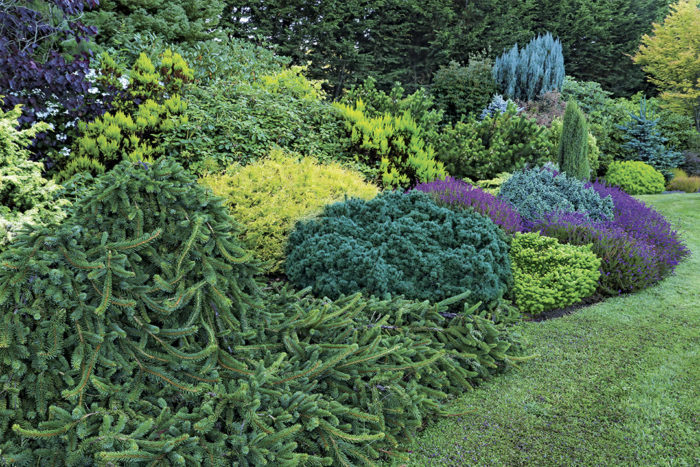
Here at the Singing Tree Gardens Nursery, we hear the same comment throughout the year: “Your gardens are so interesting and colorful!” How could any other compliment be more rewarding to a gardener?
Our display beds are designed to inspire. Customers can see how different plants will mature over time and visualize new ways to add year-round color and interest to their own landscapes. Our designs make use of contrasting foliage, plant forms, and textures, so there’s plenty to look at, even with nothing blooming. Countless cultivars could be used in place of the plants we grow here, but the design theory is the same. Here are some of the tried-and-true ideas that hold the interest of our garden visitors all year long.
Plant form is an overlooked yet important aspect of great garden design.
When Adding Color, Focus on Foliage First
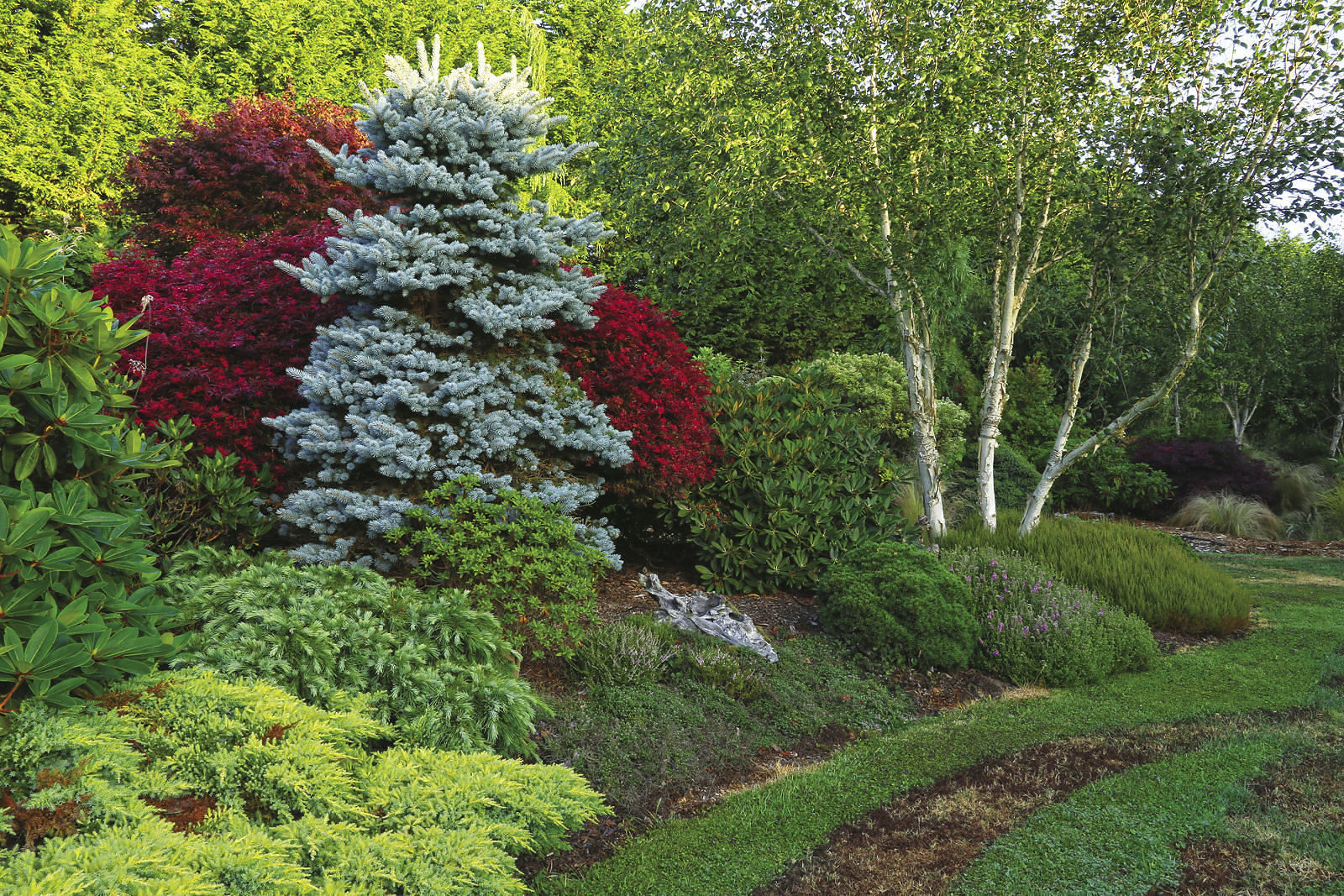
Build a sophisticated design with basic shapes and primary colors
Flowers are the first thing many people think about when they want to infuse their gardens with color. But flowers are fleeting, many lasting a few weeks or less. Flower color is an important design consideration, but only during their bloom time, and only if the chosen plants bloom at the same time. Using foliage color as a starting place will be far more rewarding through the seasons and over time.
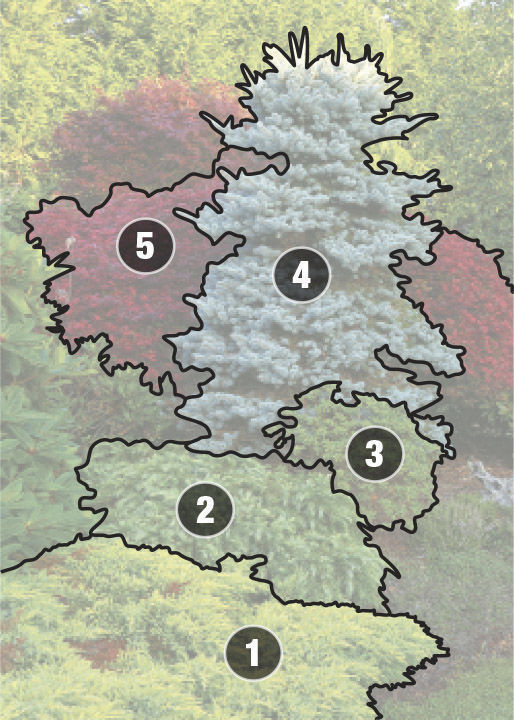
1. ‘Daub’s Frosted’ juniper (Juniperus × pfitzeriana ‘Daub’s Frosted’, Zones 4–9)
2. ‘Katere’ cedar of Lebanon (Cedrus libani ‘Katere’, Zones 5–8)
3. ‘Vibrant Violet’ rhododendron (Rhododendron ‘Vibrant Violet’, Zones 7–9)
4. ‘R. H. Montgomery’ blue spruce (Picea pungens ‘R. H. Montgomery’, Zones 3–7)
5. ‘Shaina’ Japanese maple (Acer palmatum ‘Shaina’, Zones 5–9)
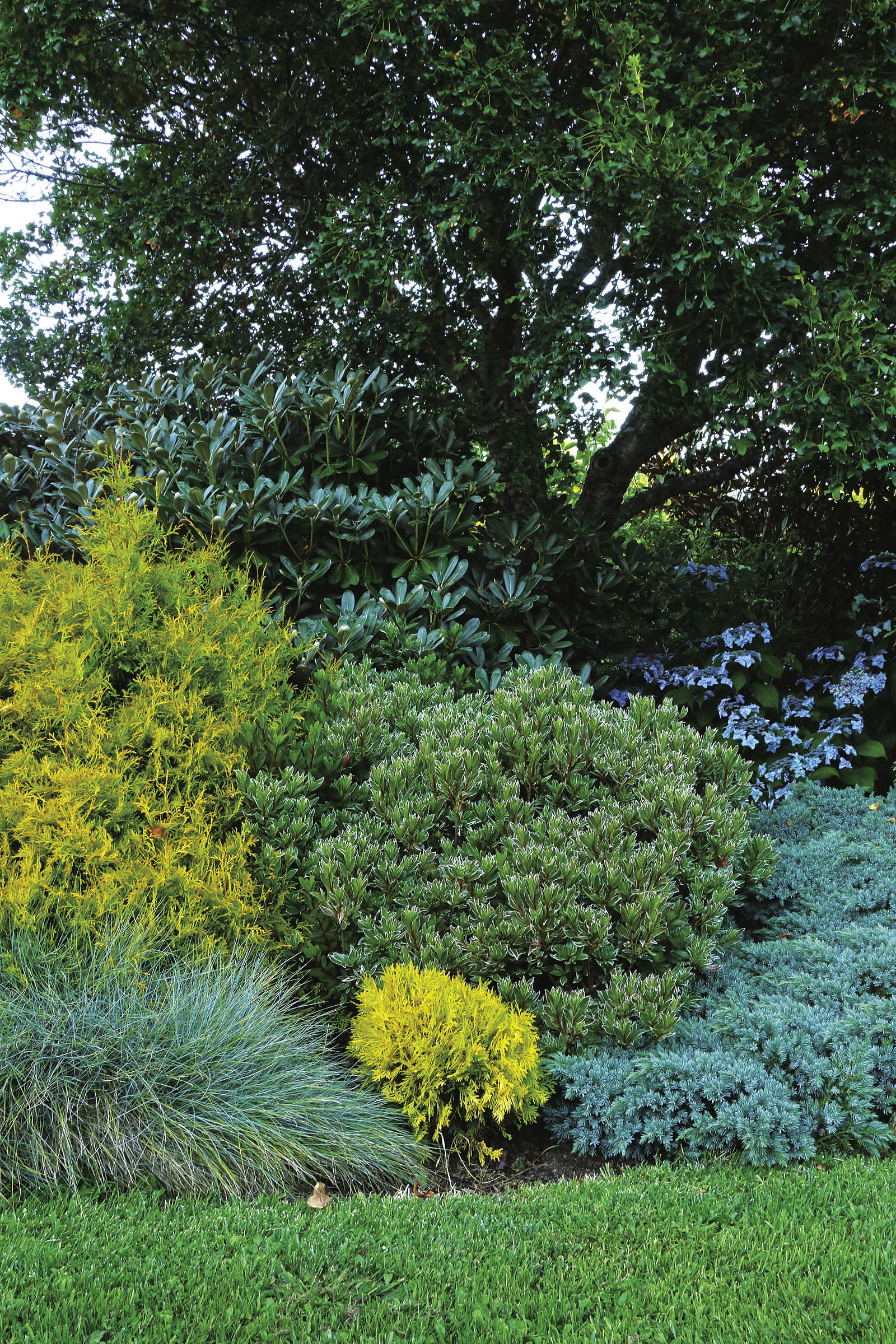
Anchor plant combinations with selections that provide year-round color
Our nursery specializes in dwarf conifers, many of which offer excellent color throughout the year. For a consistent steel blue, ‘Blue Star’ juniper (above) is a true star. It stays small, is drought tolerant, and has branch tips that are star shaped when viewed from above. I recommend ‘Rheingold’ arborvitae for a bright gold that holds through the seasons. Its warm color will contrast well with all of those beautiful greens you already have in your garden.
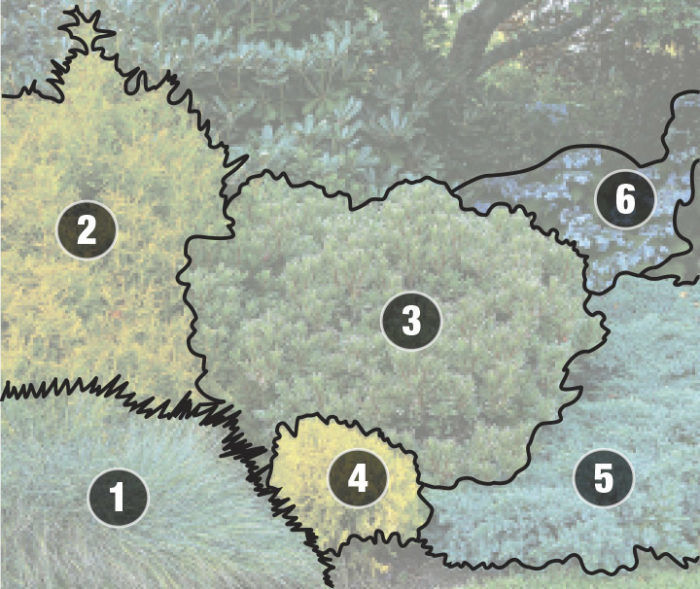
1. ‘Elijah Blue’ fescue (Festuca glauca ‘Elijah Blue’, Zones 4–8)
2. ‘Rheingold’ arborvitae (Thuja occidentalis ‘Rheingold’, Zones 2–7)
3. ‘Silver Sword’ azalea (Rhododendron ‘Silver Sword’, Zones 6–9)
4. Amber Gold arborvitae (T. occidentalis ‘Jantar’, Zones 4–7)
5. ‘Blue Star’ juniper (Juniperus squamata ‘Blue Star’, Zones 2–9)
6. ‘Blue Wave’ hydrangea (Hydrangea macrophylla ‘Blue Wave’, syn. ‘Mariesii Perfecta’, Zones 5–9)
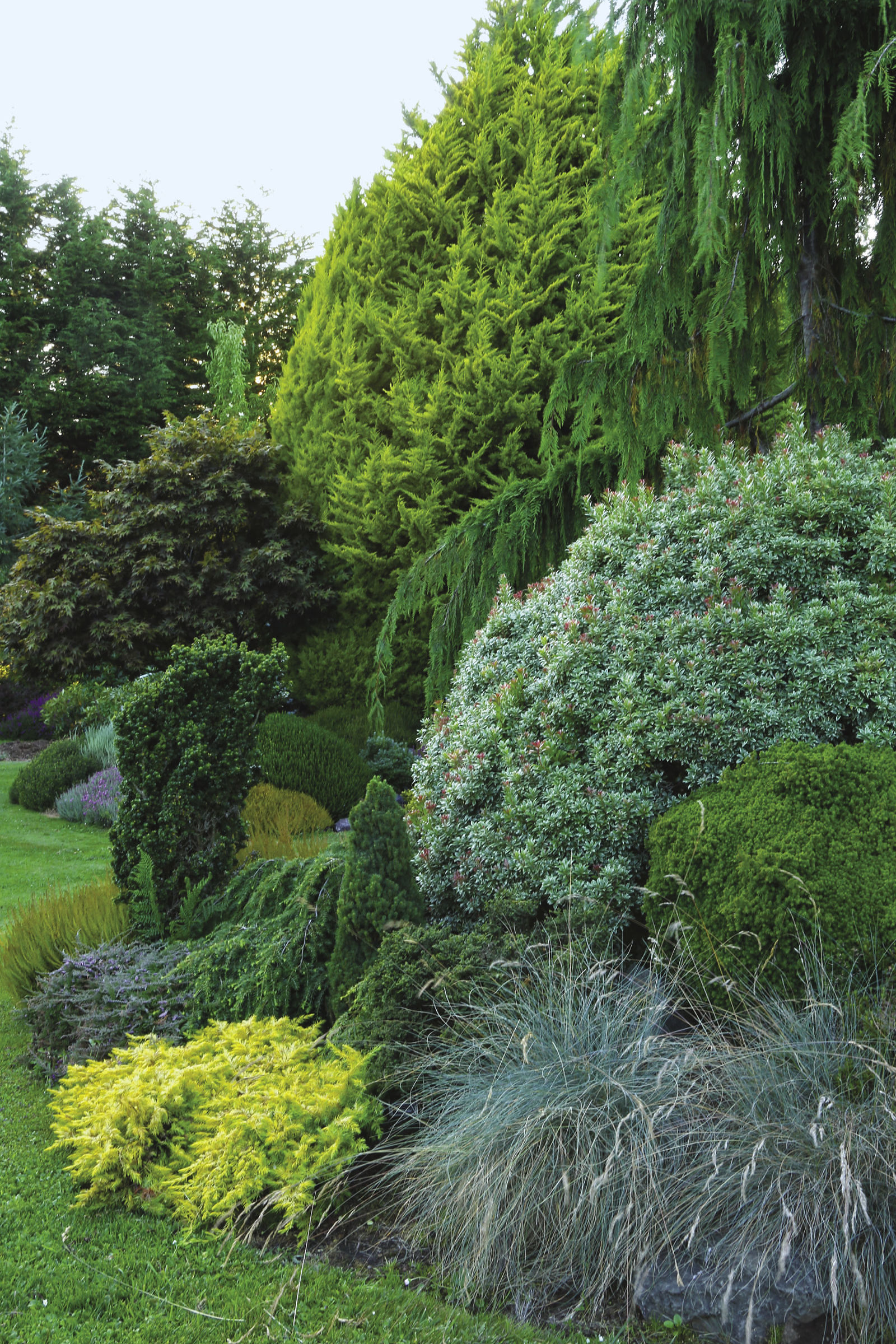
Texture and form can take the spotlight
‘Little Heath’ pieris (above) is another selection worth mentioning for its year-round color. This deer-proof, broadleaf evergreen has green, white, and pink foliage that offers shimmering year-round contrast to just about any other plant. Its rose-tinged new growth presents the illusion of a plant that is perpetually in bloom, with white spring flowers as a beautiful bonus.

1. ‘All Gold’ juniper (Juniperus conferta ‘All Gold’, Zones 6–8)
2. ‘Elijah Blue’ fescue (Festuca glauca ‘Elijah Blue’, Zones 4–8)
3. ‘Gnome’ Alberta spruce (Picea glauca ‘Gnome’, Zones 4–8)
4. ‘Little Heath’ pieris (Pieris japonica ‘Little Heath’, Zones 5–9)
5. ‘Dwarf Pagoda’ Japanese holly (Ilex crenata ‘Dwarf Pagoda’, Zones 5–7)
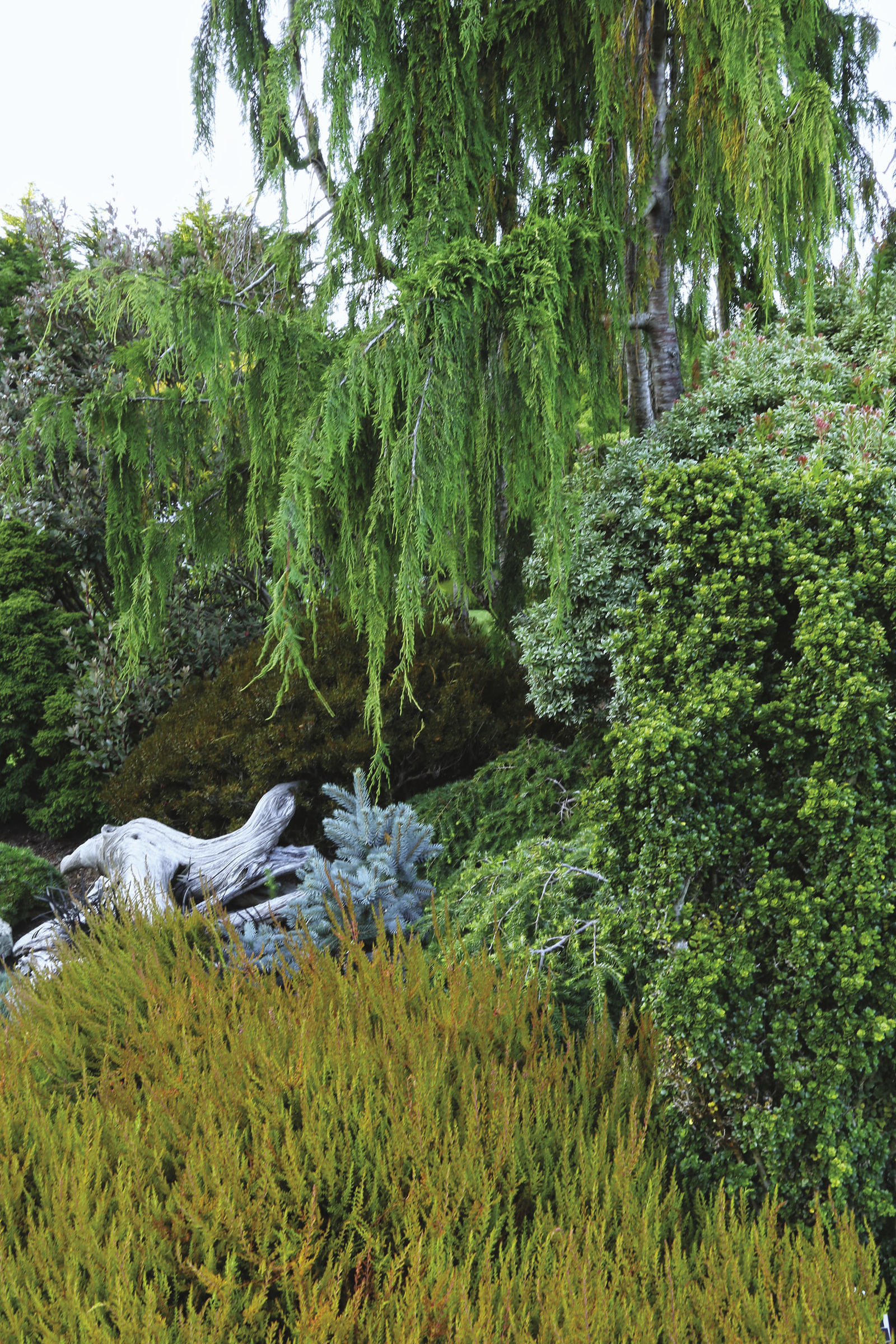
Ground covers don’t have to be green
Some plants bring color to the garden during a specific season. ‘Firefly’ heather (above) is one of the most noticed and loved plants in our gardens. Its foliage ranges from yellow to lime during the growing season, deepening to a striking brick red in the winter months. I also love the smaller mounding dissectum maples (Acer palmatum var. dissectum cvs., Zones 5–8) for their rich red foliage in spring, summer, and fall. A dark-leaved tree like ‘Purple Fountain’ beech (below) can be a stunning backdrop that makes colorful companions seem even more vibrant.
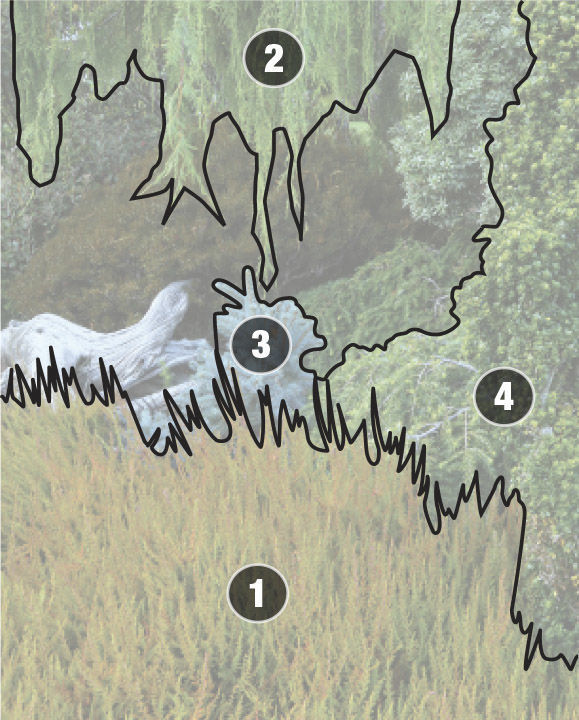
1. ‘Firefly’ heather (Calluna vulgaris ‘Firefly’, Zones 5–8)
2. ‘Green Arrow’ Alaskan cedar (Cupressus nootkatensis ‘Green Arrow’, Zones 4–8)
3. ‘Baby Blue Eyes’ Colorado spruce (Picea pungens ‘Baby Blue Eyes’, Zones 3–7)
4. ‘Dwarf Pagoda’ Japanese holly (Ilex crenata ‘Dwarf Pagoda’, Zones 5–7)
A sweep of inky leaves brings out the beauty of brighter colors
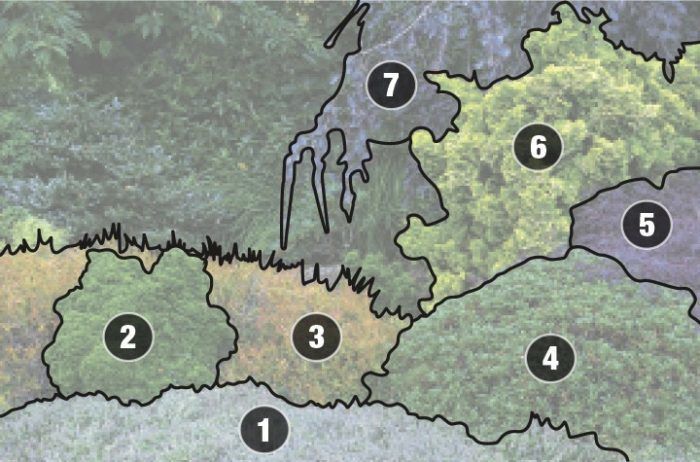
1. ‘Pink Chintz’ thyme (Thymus serpyllum ‘Pink Chintz’, Zones 5–8)
2. ‘Hage’ hinoki cypress (Chamaecyparis obtusa ‘Hage’, Zones 4–8)
3. ‘Robert Chapman’ heather (Calluna vulgaris ‘Robert Chapman’, Zones 5–8)
4. ‘Curlew’ rhododendron (Rhododendron ‘Curlew’, Zones 6–8)
5. ‘Red Dragon’ Japanese maple (Acer palmatum var. dissectum ‘Red Dragon’, Zones 5–8)
6. ‘Nana Lutea’ hinoki cypress (Chamaecyparis obtusa ‘Nana Lutea’, Zones 4–8)
7. ‘Purple Fountain’ beech (Fagus sylvatica ‘Purple Fountain’, Zones 4–7)
Texture Takes a Design to the Next Level
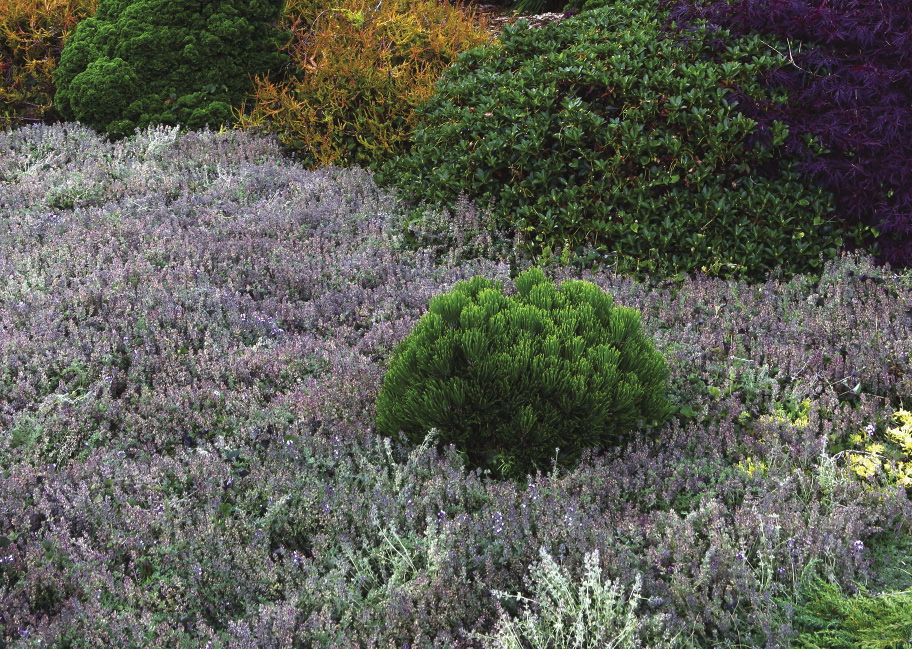
Spotlight a specimen
The majority of garden shrubs have small to medium size leaves. To provide contrast, we like to use ornamental grasses, dwarf conifers, and fine-textured ground covers. Grasses offer textures that range from spiky to fluffy, and they move in the breeze. We also love our dwarf conifers; there is probably no other plant group that offers such a diverse range of textures. You can choose among bold clouds of needles, delicate, shell-like sprays, or soft, feathery foliage to create a distinctive design. Ground covers are another great way to add garden texture. Try mixing low-growing plants with contrasting foliage to build an unexpected base layer for a garden bed. We like to use different types of thyme (Thymus spp. and cvs., Zones 4–9) for soft textures that set off just about any other plant. For a simple yet striking effect, take a cue from Japanese garden design and try “floating” a miniature conifer in an expanse of ground cover to simulate a rock in the ocean (above).
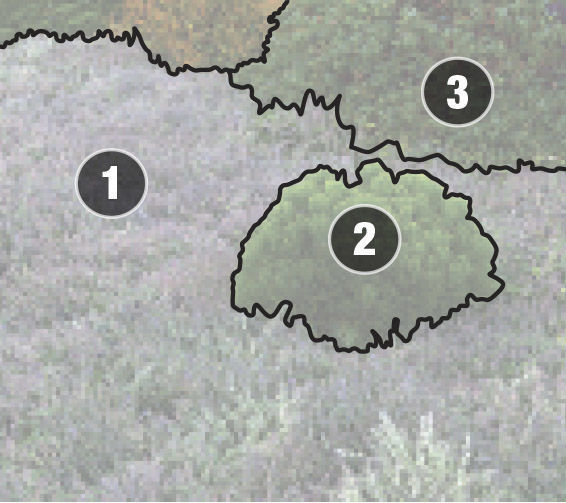
1. ‘Pink Chintz’ thyme (Thymus serpyllum ‘Pink Chintz’, Zones 5–8)
2. ‘Schmidtii’ Bosnian pine (Pinus leucodermis ‘Schmidtii’, Zones 4–8)
3. ‘Curlew’ rhododendron (Rhododendron ‘Curlew’, Zones 6–8)
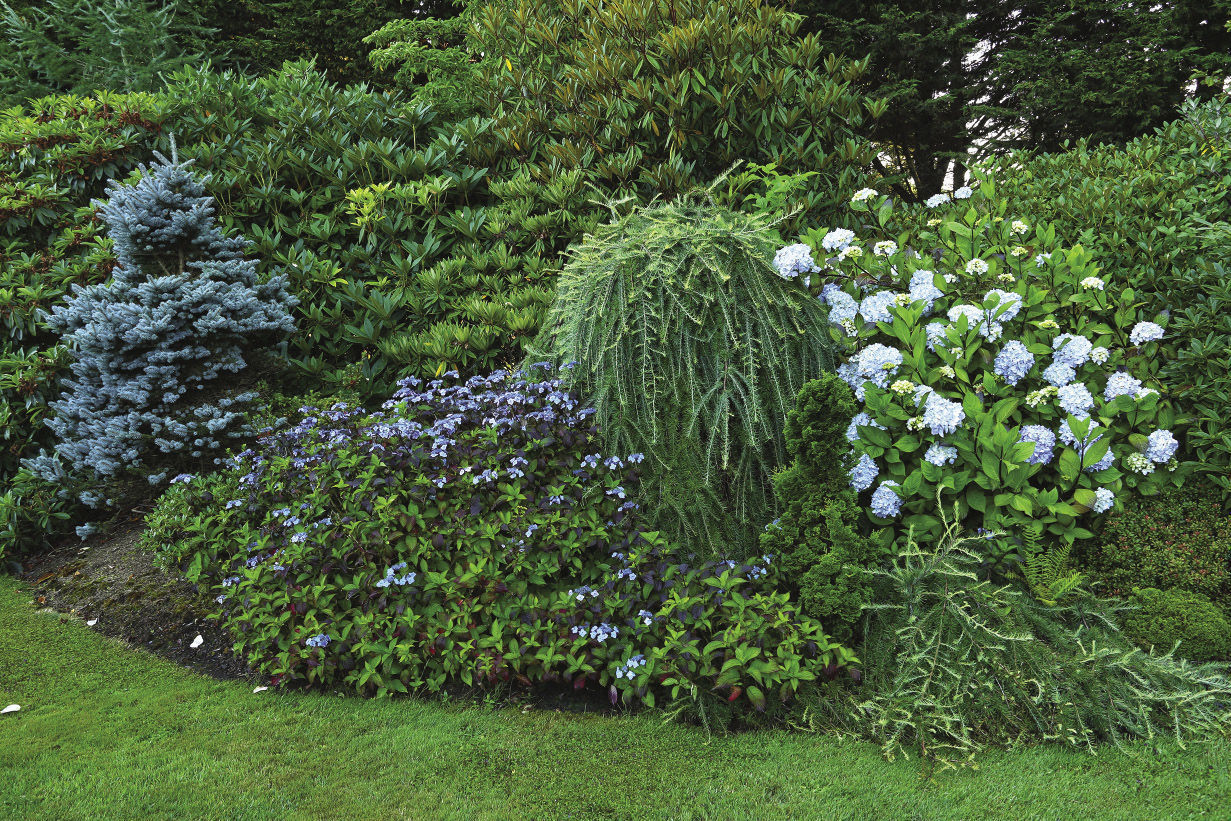
For a structured design, don’t forget about form
Plant form is an overlooked yet important aspect of great garden design. Most landscapes contain many mounding forms, so contrasting shapes will draw the eye. Spire-shaped plants are like exclamation points in the garden; they demand attention.
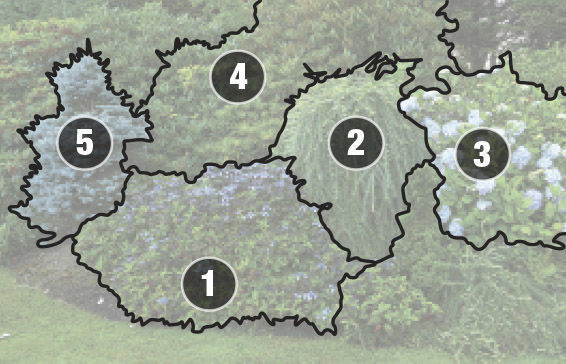
Stake weeping forms to help them look their best
Weeping forms also provide excellent contrast, and, if positioned near plants that have upward-pointing leaves, their directional growth will stand out even more. Most weeping conifers will need staking to get them up high enough to create their “look.”
1. ‘Blue Billow’ mountain hydrangea (Hydrangea serrata ‘Blue Billow’, Zones 5–7)
2. Japanese larch (Larix kaempferi ‘Pendula’, Zones 5–7)
3. ‘Nigra’ bigleaf hydrangea (Hydrangea macrophylla ‘Nigra’, Zones 6–9)
4. ‘Red Majesty’ rhododendron (Rhododendron ‘Red Majesty’, Zones 7–9)
5. ‘R. H. Montgomery’ blue spruce (Picea pungens ‘R. H. Montgomery’, Zones 3–7)
If you focus on the plant silhouettes in your own designs, you’ll likely see many opportunities to add more drama and directionality with contrasting forms. Working with plant features like foliage color, texture, and form, you will never be disappointed.
| Basics |
Choosing and Planting a Conifer
A conifer can be a substantial garden purchase, so think ahead and be strategic when choosing and planting one. Here are some things to consider.
Conifers are a long-term investment.
These plants are very rugged—they are all basically some species of forest tree. Many cultivars will stay small and may grow for several years or even decades with little to no maintenance.
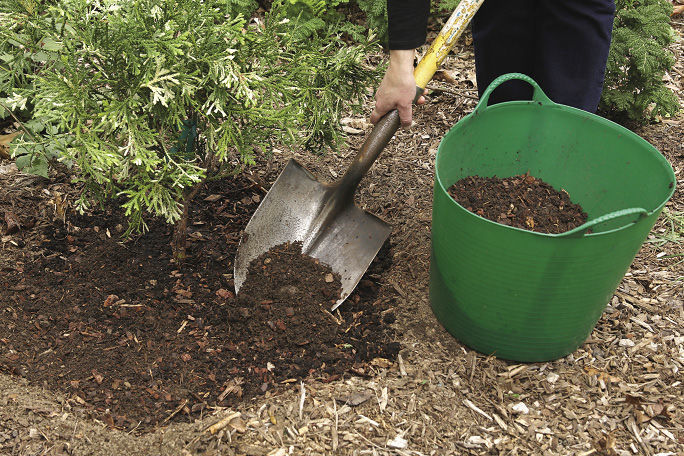
Most conifers need well-drained soil that’s rich in organic matter.
Some sand or gritty soil mixed with generous quantities of bark is my favorite mix. Stay away from “potting soil,” which does not drain well and becomes “sludgy” over time. You should also avoid peat moss, which will often cause root rot. I have found that coarse bark has “anti-root rot” qualities and will not become anaerobic over time.
If you have the option of making a raised bed, you will be happy you did. Most conifers appreciate the improved drainage that a raised bed provides.
You can choose a growth rate that suits your needs.
When selecting a conifer for your space, it is helpful to know the terms used to describe conifers’ rates of growth.
• Miniature conifers grow less than 1 inch per year. A typical miniature will be 10 inches tall or less at 10 years and twice as wide.
• Dwarf conifers grow between 1 and 6 inches per year, with most in this group reaching 2 to 6 feet tall in 10 years.
• “Intermediate size” refers to conifers that grow 6 to 12 inches per year, with most being 6 to 15 feet tall.
• Large conifers grow more than 12 inches per year, the majority reaching 15 feet tall or greater.
Don Wallace is the owner and manager of Singing Tree Gardens Nursery, a specialty nursery in McKinleyville, California.
Photos: Carol Collins

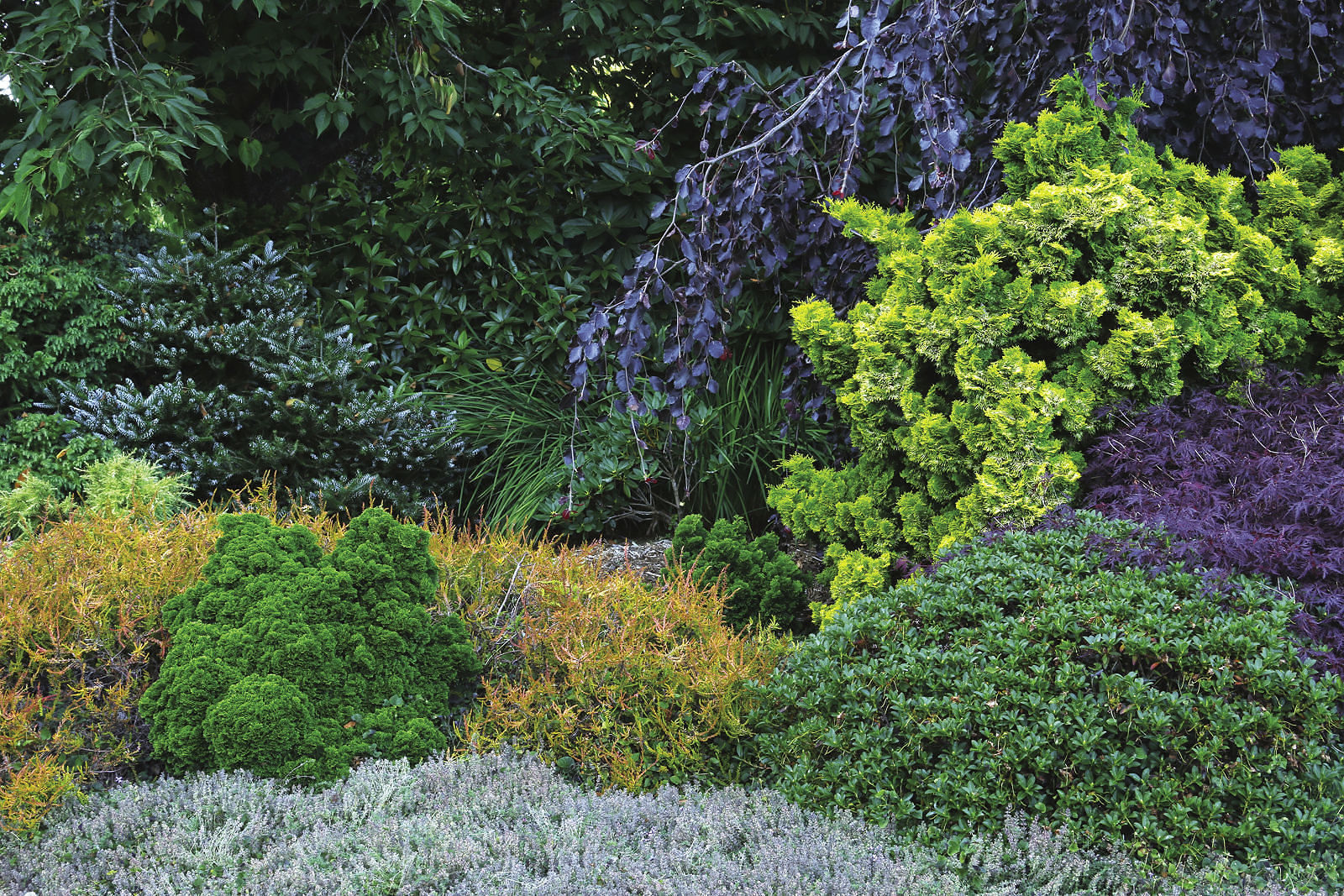

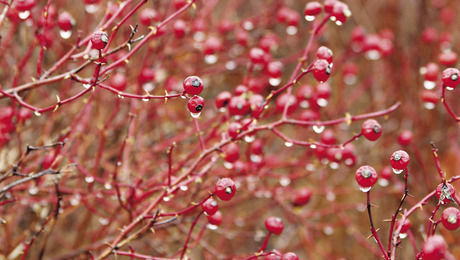














Comments
Log in or create an account to post a comment.
Sign up Log in